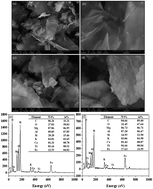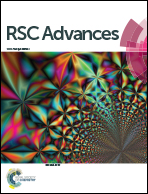Efficient and fast removal of Pb(ii) by facile prepared magnetic vermiculite from aqueous solution
Abstract
Magnetic modified vermiculite was prepared by a simple one-pot solvothermal method to remove lead from aqueous solution. The physiochemical properties of vermiculite and magnetic vermiculite were analyzed by X-ray diffraction (XRD), surface-enhanced Raman scattering (SERS), Fourier transform infrared (FTIR) spectroscopy, scanning electron microscope (SEM) with energy dispersive spectroscopy (EDS), transmission electron microscope (TEM), specific surface area determination, and magnetic property and zeta potential measurement. The results proved that the vermiculite was successfully functionalized by nanoparticles of Fe3O4. The magnetic vermiculite had superparamagnetic property and higher specific surface areas (52.6 cm3 g−1). Batch adsorption experiments of Pb(II) by vermiculite and magnetic vermiculite were carried out. The results indicated that the adsorption isotherm and kinetic data followed the Langmuir model and the pseudo-second-order equation, respectively. The adsorption process of vermiculite and magnetic vermiculite was fast and the maximum adsorption capacities were 37.0 mg g−1 and 70.4 mg g−1, respectively. In addition, the magnetic vermiculite can be fleetly and easily separated using a magnet after adsorption. It has good potential for cost-effective treatment of lead-contaminated wastewater.


 Please wait while we load your content...
Please wait while we load your content...